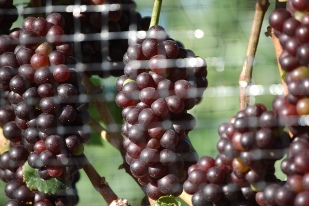|
Carmenere is Chile's recognized wine is eager to please.Carmenere grape is a wine grape variety originally planted in the Médoc region of Bordeaux, France, where it was used to produce deep red wines and occasionally used for blending purposes in the same manner as Petit Verdot. A member of the Cabernet family of grapes, the name "Carmenere" originates from the French word for crimson (carmin) which refers to the brilliant crimson color of the autumn foliage prior to leaf-fall. The grape is also known as Grande Vidure, a historic Bordeaux synonym, although current European Union regulations prohibit Chilean imports under this name into the European Union. Along with Cabernet Sauvignon, Cabernet franc, Merlot, Malbec and Petit verdot, Carmenere is considered part of the original six red grapes of Bordeaux, France. Now rarely found in France, the world's largest area planted with this variety is in Chile in South America, with more than 8,800 hectares (2009) cultivated in the Central Valley. As such, Chile produces the vast majority of this red wine is available today and as the Chilean wine industry grows, more experimentation is being carried out on Carmenere's potential as a blending grape, especially with Cabernet Sauvignon. This red wine grape is also grown in Italy's Eastern Veneto and Friuli-Venezia Giulia regions and in smaller quantities in the California and Walla Walla regions of the United States.
One of the most ancient European varieties, it is thought to be the antecedent of other better-known varieties; some consider the grape to be a clone of Cabernet Sauvignon. It is possible that the variety name is an alias for what is actually the Vidure, a local Bordeaux name for a Cabernet Sauvignon clone once thought to be the grape from which all red Bordeaux varieties originated. There have also been suggestions that this red wine grape may be Biturica, a vine praised in ancient Rome and also the name by which the city of Bordeaux was known during that era. This ancient variety originated in Iberia (modern-day Spain and Portugal), according to Pliny the Elder; indeed, it is currently a popular blending variety with Sangiovese in Tuscany called "Predicato di Biturica" The red grape has known origins in the Médoc region of Bordeaux, France and was also widely planted in the Graves until the vines were struck with oidium. It is almost impossible to find this red wine in France today, as a Phylloxera plague in 1867 nearly destroyed all the vineyards of Europe, afflicting the grapevines in particular such that for many years the grape was presumed extinct. When the vineyards were replanted, growers could not replant Carmenere as it was extremely hard to find and more difficult to grow than other grape varieties common to Bordeaux. The region's damp, chilly spring weather gave rise to coulure, "a condition endemic to certain vines in climates which have marginal, sometimes cool, wet springs", which prevented the vine's buds from flowering. Yields were lower than other varieties and the crops were rarely healthy; consequently wine growers chose more versatile and less coulure-susceptible grapes when replanting the vines and planting was progressively abandoned.
Far from being extinct, in recent years the Carmenere grape has been discovered at Viña Carmen to be thriving in several areas outside of France. In Chile, growers almost inadvertently preserved the grape variety during the last 150 years, due largely to its similarity to Merlot. Cuttings were imported by Chilean growers from Bordeaux during the 19th century, where they were frequently confused with Merlot vines. They modeled their wineries after those in France and in the 1850s cuttings from Bordeaux, which included this red wine grape, were planted in the valleys around Santiago. Thanks to Chile's minimal rainfall during the growing season and the protection of the country's natural boundaries, growers produced healthier crops of the red wine grape and there was no spread of phylloxera. During most of the 20th century this red wine grape was inadvertently collected and processed together with Merlot grapes (probably reaching up to 50% of the total volume) giving Chilean Merlot markedly different properties to those of Merlot produced elsewhere. Chilean growers believed that this grape was a clone of Merlot and was known as Merlot selection or Merlot Peumal (after the Peumo Valley in Chile). In 1994, Professor Jean-Michel Boursiquot from the Montpellier's school of Oenology confirmed that an earlier-ripening vine was Bordeaux Carmenere, not Merlot. The Chilean Department of Agriculture officially recognized Carmenere as a distinct variety in 1998. Today, it grows chiefly in the Colchagua Valley, Rapel Valley, and Maipo Province.
|
Sign up for weekly Red Wine Reviews
CLICK HEREWe will send you the extremely popular Red-Wine-Home tasting terms when you sign-up.






